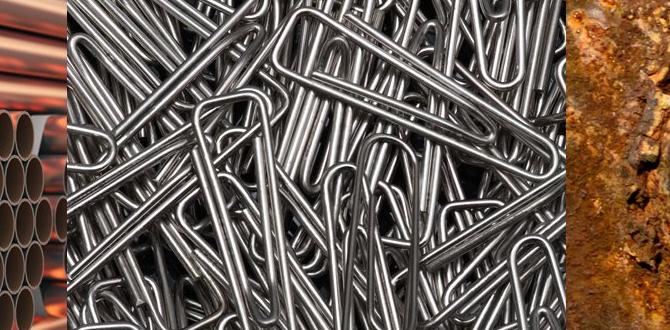Carbide end mills excel at steel chip evacuation, ensuring smoother cuts and longer tool life. Understanding flute geometry, coatings, and proper machining strategies dramatically improves performance, preventing heat buildup and catastrophic tool failure. This guide will demystify effective chip evacuation for steel with carbide end mills.
Hey there, fellow makers! Daniel Bates here from Lathe Hub. Ever found yourself wrestling with a carbide end mill and stubborn steel chips? It’s a common frustration, right? Those little metal curls can build up, jam your tool, and send vibrations straight to your workpiece. This not only ruins your finish but can also break your expensive end mill. Don’t worry, though! Getting steel chips to clear out smoothly is totally achievable, even for beginner machinists. We’ll dive into the simple secrets behind chip evacuation that will make your steel milling projects a breeze. Get ready to make those end mills sing!
Why Chip Evacuation is Critical When Milling Steel
When you’re cutting steel with a carbide end mill, it’s like a miniature battle happening at the tip of your tool. The sharp edges of the end mill shear away material, creating chips. What happens to those chips is super important for a successful cut. If they don’t get out of the way quickly, they can cause all sorts of problems.
Imagine trying to dig a hole with a shovel, but you keep pushing dirt back into the spot you’re trying to dig. That’s kind of what happens when chips don’t evacuate properly. They can clog up the flutes (the spiral grooves) of your end mill. This leads to increased friction and heat. Steel is already a tough material to machine, and adding extra heat is like throwing gasoline on a fire; it makes everything worse. This excess heat can:
Soften the carbide: Even though carbide is hard, extreme heat can reduce its hardness, dulling the cutting edges faster.
Weld chips to the tool: Hot chips can actually melt and stick to the end mill, essentially blunting it instantly.
Cause tool breakage: The extra forces and heat can lead to the end mill snapping.
Degrade the surface finish: When chips aren’t cleared, they get re-cut, leading to a rough, unsightly surface on your workpiece.
Good chip evacuation means those metal shavings are flung away from the cutting zone efficiently. This keeps the cutting edge cool, allows it to cut cleanly, and extends the life of your end mill. It’s the key to making milling steel a smooth, predictable process.
Understanding Carbide End Mill Basics for Chip Evacuation
Carbide end mills are fantastic for cutting harder materials like steel, but their design is crucial for getting those chips out. Let’s break down the key features that help them do this job well:
Flute Count: Fewer Flutes, Better Chip Space
The flutes are those spiral grooves that run along the length of the end mill. Their main jobs are to cut the material and then provide a path for the chips to escape.
2-Flute End Mills: These are often the best choice for milling steel, especially when chip evacuation is a concern. With only two cutting edges and wider spaces between them (larger gullets), there’s more room for chips to form and travel up and out of the cut. This is especially important in deeper slots or when working with materials that produce stringy chips.
3-Flute End Mills: These offer a smoother cut and can sometimes handle higher feed rates than 2-flute mills because they have more cutting edges to distribute the load. However, the flutes are narrower, which can make chip evacuation more challenging in gummy materials or deep cuts. They are often a good compromise for general-purpose milling of steel where chip packing isn’t extreme.
4-Flute End Mills: These provide the smoothest finish and can handle the stiffest materials by distributing the cutting load across more edges. However, their narrower flutes make them the least effective for chip evacuation. They are generally not recommended for slotting or milling materials that produce long, stringy chips. They work best for peripheral milling (around the outside of a part) where chips have plenty of room to escape.
For steel and good chip evacuation, especially in slots, 2-flute end mills are often king.
Helix Angle: The Spiral’s Role
The helix angle is the degree of the spiral of the flutes.
Standard Helix (around 30 degrees): This is common for general-purpose end mills and offers a good balance of cutting performance and chip control.
High Helix (45 degrees or more): End mills with a higher helix angle are designed to “bite” into the material more aggressively. For steel, a higher helix can actually help “throw” chips away from the cut more effectively, improving evacuation. They can reduce chatter and provide a smoother finish, though they might require slightly different machining parameters.
Core Diameter (or Neck) and Relief
Core Diameter: This is the diameter of the solid part of the end mill at the center, before the flutes start. A larger core diameter generally makes the end mill stronger and more rigid, which is good for tough materials like steel.
Chip Gullet: This refers to the space between the flutes. As mentioned with flute count, wider chip gullets are better for evacuation.
Swirl Relief: Some specialized end mills have a ground relief behind the cutting edge. This is designed to help chips flow more freely up the flute and away from the cutting zone.
Specialized End Mill Designs for Enhanced Chip Evacuation
Beyond the basic flute count and helix angle, some end mill designs are specifically engineered to tackle chip evacuation challenges in materials like steel.
Chip Breaker / Serrated Edges
Some end mills have small serrations or notches ground into the cutting edges of the flutes. These are called chip breakers. Their job is to intentionally break the long, stringy chips produced by materials like steel into smaller, more manageable pieces. These smaller chips are much easier to evacuate from the flutes without packing or clogging.
Pros: Significantly improves chip control and evacuation in stringy materials. Reduces the risk of re-cutting chips.
Cons: Can sometimes lead to a slightly rougher surface finish compared to a plain-edge end mill. May not be ideal for very fine finishing passes.
High-Performance Coatings
Coatings are thin layers applied to the surface of the carbide end mill. They’re not just for show; they play a crucial role in reducing friction and heat, which directly impacts chip evacuation and tool life.
TiN (Titanium Nitride): A classic, general-purpose coating. It’s gold in color and offers improved hardness and reduced friction. Good for moderate speeds and steels.
TiCN (Titanium Carbonitride): Darker gray/blue. Harder than TiN and offers better abrasion resistance. Good for steels and cast iron.
TiAlN (Titanium Aluminum Nitride) / AlTiN (Aluminum Titanium Nitride): These are excellent choices for machining steels, especially alloy steels and stainless steels. They form a protective aluminum oxide layer at high temperatures, which is very hard and provides excellent thermal resistance. This allows for higher cutting speeds and significantly improves tool life. They typically have a dark, purplish hue.
ZrN (Zirconium Nitride): Similar to TiN but often provides better lubricity, which can help with chip flow and prevent sticking.
DLC (Diamond-Like Carbon): Extremely hard and low-friction. Excellent for abrasive materials and can dramatically improve chip evacuation and prevent built-up edge. Often used for aluminum but can be beneficial for some steels.
For milling steel, TiAlN/AlTiN coatings are usually the go-to for their exceptional performance at high temperatures.
Through-Coolant Capabilities
This is a game-changer for steel machining. Many modern end mills, especially those designed for production or demanding materials, have internal passages that allow coolant to be delivered directly through the center of the end mill and out near the cutting edges.
How it helps chip evacuation: The pressurized coolant jet actively flushes chips away from the cutting zone and out of the flutes. It also keeps the cutting edge cool, which reduces friction and prevents chips from welding to the tool.
Using through-coolant can dramatically improve your ability to mill steel effectively, especially in deep pockets or when dealing with materials that tend to produce gummy chips.
Strategies for Effective Chip Evacuation When Milling Steel
Having the right tool is only half the battle. How you use the end mill is just as important, especially when it comes to clearing those pesky chips.
1. Choose the Right End Mill for the Job
As we discussed, this means selecting:
Flute Count: Generally, 2-flute for slotting and tough materials, 3-flute for a balance, and 4-flute for finishing where chip exit isn’t an issue.
Coating: TiAlN/AlTiN for most steels.
Features: Consider chip breakers or through-coolant capabilities if you’re having recurring problems.
Stub vs. Standard vs. Extended Length: Shorter stub-length end mills are more rigid and less prone to vibration, which can help with chip control. However, they limit your reach. For deeper cuts, you might need a longer end mill, but be prepared for increased chatter and the need for more robust chip evacuation strategies.
2. Optimize Your Machining Parameters (Speeds and Feeds)
This is a delicate balancing act.
Cutting Speed (SFM – Surface Feet per Minute): Higher speeds can sometimes help to “throw” chips away, but too high a speed generates excessive heat, which is detrimental. For steel, start with recommended speeds for your carbide grade and coating, and adjust based on tool wear and chip formation.
Feed Rate (IPM – Inches per Minute): This is critical.
Chip Load: This is the thickness of the chip being removed by each tooth of the end mill. For steel, you want to achieve a chip load that is thick enough to form a proper chip but not so thick that it overloads the tool or prevents evacuation. A common starting point for 1/4″ carbide end mills in steel might be around 0.001″ to 0.003″ chip load per tooth.
Too Light a Chip Load: Produces tiny, wispy chips that don’t evacuate well and can lead to excessive heat and premature tool wear (rubbing instead of cutting).
Too Heavy a Chip Load: Can shock the tool, lead to chatter, and may overwhelm the flutes’ capacity to clear chips.
Depth of Cut (DOC) and Width of Cut (WOC):
When slotting (WOC ≈ End Mill Diameter): Use a shallow depth of cut (e.g., 0.5x the end mill diameter or less) and a 2-flute end mill with good chip clearance. Consider climb milling for better chip evacuation.
When profiling (WOC < End Mill Diameter): You can often take a deeper DOC. Again, use the right end mill and consider climb milling.
A good rule of thumb for steel is to aim for chips that are about 1/3 to 1/2 the thickness of a dime. They should be curly or segmented, not powdery or stringy.
3. Milling Strategy: Climb Milling vs. Conventional Milling
The direction the end mill rotates relative to the direction of feed makes a big difference.
Conventional Milling: The cutter rotates against the direction of feed. The chip starts thin and gets thicker as the tooth moves through the material. This tends to push chips away, but it creates more friction and heat and can lift the workpiece.
Climb Milling: The cutter rotates in the same direction as the feed. The chip starts thick and gets thinner. This results in less friction, less heat, and a better surface finish. Crucially for chip evacuation, climb milling tends to “throw” chips out of the cut more effectively, especially when combined with through-coolant.
For steel and good chip evacuation, climb milling is generally preferred. It’s essential to ensure your machine has minimal backlash in its drive system for climb milling to be effective and safe.
4. Airblast and Coolant Application
This is your active chip control system.
Airblast: A strong jet of compressed air directed at the cutting zone can help blow chips away, especially in dry machining or when using mist coolant. Ensure the air is directed so it evacuates chips away from the tool and workpiece.
Mist Coolant: A combination of air and a fine oil mist. This provides some cooling and lubrication while also helping to blast chips away. It’s a good compromise when flood coolant isn’t feasible.
Flood Coolant: A high-pressure flow of coolant directly into the cutting zone. This is the most effective method for cooling and chip evacuation. When combined with through-coolant end mills, it’s incredibly powerful for steel. The coolant not only cools but actively flushes chips out, carrying them away from the tool and preventing it from getting clogged. Use a coolant formulated for steel machining.
Always ensure your coolant or airblast is directed to effectively remove chips from the flute exit.
5. Understand Your Material’s Chip Tendencies
Different types of steel behave differently:
Mild Steel / Carbon Steel: Can produce long, stringy chips that are prone to packing. Requires good chip evacuation strategies.
Stainless Steel: Often described as “gummy” or “sticky.” It tends to produce long chips and work-hardens quickly, making chip evacuation and tool cooling paramount. TiAlN/AlTiN coatings and good coolant are essential.
Tool Steel: Very hard and abrasive. Produces smaller, harder chips. Still requires good chip evacuation, but the primary challenge is tool wear due to hardness.
Knowing your material helps you select the right end mill and parameters to manage its specific chipping behavior.
Practical Applications: A Step-by-Step Example
Let’s walk through a common task: milling a slot in a piece of 1018 mild steel (a common, easy-to-machine steel). We want to mill a 1/4″ wide slot, 1/2″ deep.
Goal: Efficient chip evacuation to prevent tool breakage and achieve a good finish.
1. Select the End Mill:
Type: 2-Flute Solid Carbide End Mill. This gives us maximum chip clearance.
Diameter: 1/4 inch. This matches our desired slot width.
Length: Standard cutting length (e.g., 3/4″). A stub length would be even better for rigidity if reach allows.
Coating: TiAlN. Excellent for steel, provides heat resistance.
Features: Let’s assume it has a standard 30-degree helix. If possible, one with through-coolant would be superior.
2. Machine Setup:
Workholding: Secure the 1018 steel firmly in a vise, ensuring it won’t move.
Spindle: Ensure the machine has low backlash for climb milling.
Coolant: Set up flood coolant. If not available, use a good mist coolant or at least a strong airblast.
3. Determine Speeds and Feeds:
Material: 1018 Mild Steel.
Tool: 1/4″ 2-Flute Carbide, TiAlN coated.
Reference: Consult a carbide tooling manufacturer’s recommendations. For 1018 steel, a common starting point for a 1/4″ carbide end mill might be:
Surface Speed (SFM): Around 250-350 SFM.
Revolutions Per Minute (RPM): `RPM = (SFM 3.82) / Diameter`
`RPM = (300 3.82) / 0.25 = 4584`. Let’s round to `4500 RPM`.
Chip Load per Tooth: Aim for around 0.0015″ to 0.003″ for good chip formation without overloading. Let’s pick 0.002″.
Feed Rate (IPM): `Feed Rate = RPM Flutes Chip Load per Tooth`
`Feed Rate = 4500 2 0.002 = 18 IPM`. This might be a bit slow for a rigid machine. Many modern CNCs can handle faster feeds by adjusting the DOC/WOC. Let’s try a slightly more aggressive approach later.
4. Milling Strategy & Parameters:
Milling Direction: Climb Milling.
Depth of Cut (DOC): For a 1/2″ deep slot, we don’t want to take it all in one go. Let’s do it in 2 passes:
Pass 1: DOC = 0.25″
Pass 2: DOC = 0.25″ (to finish at 0.5″ total)
Width of Cut (WOC): We need a 1/4″ wide slot with a 1/4″ end mill. This means a full slotting operation. Your machine’s feed rate capability will be tested here. If 18 IPM feels too slow or isn’t well-supported by your machine’s control, you might need to adjust DOC down or WOC down and use multiple passes. A more typical feed for a rigid machine might be 30-50 IPM with a lighter chip load. Let’s aim for 30 IPM with a slightly lighter chip load.
Revised Feed Rate: 30 IPM
Revised Chip Load: `Chip Load = Feed Rate / (RPM * Flutes)`
`Chip Load = 30 / (4






